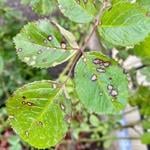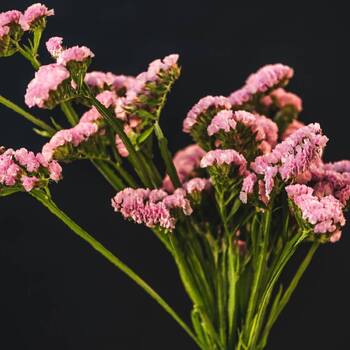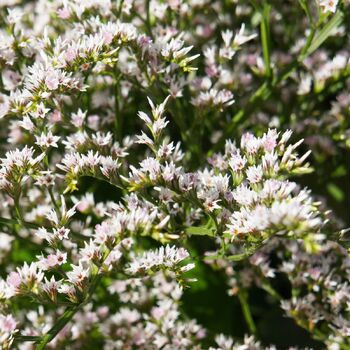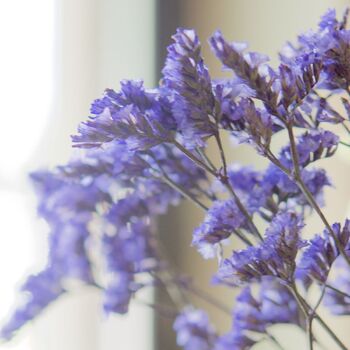
How to Grow Statice Seeds
Grow Guide #2321
Family: Plumbaginaceae
Binomial name: Limonium sinuatum
Life Cycle: Perennial (often grown as an annual)
This 'How to Grow' guide details everything a home gardener needs to know to plant, grow and care for statice (Limonium sinuatum).
Some other plants are known as 'statice' but are different species botanically. Russian statice (Psylliostachys suworowii) and German statice (Goniolimon tataricum) are two examples. This guide is still relevant as these plants are grown in the same way as statice.
When to Sow Statice Seeds
Statice is a warm season flower. Use the table below to identify the best time of year to sow statice seeds in your climate.
| JAN | FEB | MAR | APR | MAY | JUN | JUL | AUG | SEP | OCT | NOV | DEC | |
|---|---|---|---|---|---|---|---|---|---|---|---|---|
| Cool | ||||||||||||
| Temperate | ||||||||||||
| Sub-Tropical | ||||||||||||
| Tropical | ||||||||||||
| Arid |
Preparation
Statice plants are best grown in full sun. Choose a location that will receive at least 6 hours of full sun each day.
Statice plants need a well drained soil enriched with plenty of organic matter. Prepare soil by weeding it thoroughly, digging it over to loosen it and adding aged animal manure or compost. Keep the area free of weeds until planting. Learn more about preparing soil for planting here.
Statice plants can be grown in containers. If possible choose a variety that’s recommended for container growing. Use a good quality potting mix and make sure your container is large enough for mature plants; a minimum of 10 litres is recommended for statice. During the growing season, keep in mind that container grown plants may need additional fertiliser to encourage healthy growth.
How to Sow Statice Seeds
Statice seeds do not require any treatment (eg soaking, stratification) before sowing.
Statice seeds grow best when they are sown directly into the garden.
- Sow seeds directly in the garden 5mm deep and 30-40cm apart.
- Keep soil moist but never wet or dry.
- Seeds should germinate in around 7-14 days at a soil temperature of 22-24°C.
- Young seedlings will need protection from pests, pets and weather until they are established.
Statice is a half hardy crop. Mature plants will survive light frosts but seedlings need protection until they are established. Do not transplant seedlings or sow seeds outside until all danger of frost has passed.
Tip: Statice seeds can also be sown in the less formal ‘scatter seed’ method. Simply roughen the soil, scatter seeds evenly over the surface, then smooth the soil over lightly to cover the seeds.
How to Grow Statice
Statice plants are drought tolerant once established and grow best in soil that is dry and very well drained. Let the soil dry out between watering, and only water when the soil is dry about 10cm below the surface (test this by scratching away a little soil with your finger), even in summer. Water deeply in the early morning or late afternoon. Avoid watering the leaves of plants to avoid fungal diseases. Learn more about watering here.
If soil was well prepared no extra fertiliser should be necessary. In poor soil or to give your plants an extra boost, application of a high-potassium fertiliser or one formulated for flowering plants can be beneficial:
- Apply slow release fertiliser at the recommended rate when transplanting or when seedlings are 5-10cm tall.
- Apply liquid fertiliser at the recommended rate and frequency while plants are fruiting or flowering.
Optional: To give plants room to grow, thin seedlings when they are large enough to handle. Pull out any weak or small seedlings so plants are spaced about 30-40cm apart.
Statice plants should flower in approximately 150 days.
Deadhead statice flowers regularly during the growing season. Using sharp secateurs or snips cut fading or dead flowers off just above a set of leaves. Removing old flowers regularly will encourage plants to produce more flowers. Learn more about deadheading flowering plants here.
If growing statice for cut flowers, use sharp snips or secateurs to cut the longest stems possible, removing the lower leaves and placing the stems immediately in a clean bucket of water. Learn more about cutting and conditioning homegrown flowers here.
Statice plants may die back in cold weather. Cut plants back just above ground level in late autumn, or prune off dead foliage when new leaves emerge in spring.
Common Problems when Growing statice
Like all plants, statice is susceptible to some pests, diseases and other problems. Below is a list of the most common problems gardeners encounter when growing statice plants:
 Bacterial leaf spot is a disease that causes irregularly shaped brown spots on all above-ground parts of a plant. The spots at first appear to be wet but become dry and scab-like over time. Leaves and flowers can fall prematurely. Water plants at soil level (not on the leaves), dispose of fallen leaves and fruit and practice crop rotation.
Bacterial leaf spot is a disease that causes irregularly shaped brown spots on all above-ground parts of a plant. The spots at first appear to be wet but become dry and scab-like over time. Leaves and flowers can fall prematurely. Water plants at soil level (not on the leaves), dispose of fallen leaves and fruit and practice crop rotation. Grey mould (Botrytis sp.) is a fungal disease that causes flowers to become mouldy and fruit to rot. Spores are transported by wind and can survive in soil or on green waste. The fungus spreads most in cool, damp weather. Prune off affected flowers and fruit, water plants at soil level (not on leaves) and if necessary spray with an appropriate fungicide or homemade spray.
Grey mould (Botrytis sp.) is a fungal disease that causes flowers to become mouldy and fruit to rot. Spores are transported by wind and can survive in soil or on green waste. The fungus spreads most in cool, damp weather. Prune off affected flowers and fruit, water plants at soil level (not on leaves) and if necessary spray with an appropriate fungicide or homemade spray. Red leaves in cool weather are caused by exposure to cold temperatures. Some plants accumulate anthrocyanin, a red pigment, in their leaves as a defence against cold weather. If growing in containers, move plants to a sheltered position over winter. Plants will generally recover and leaves will return to a green colour once temperatures warm up.
Red leaves in cool weather are caused by exposure to cold temperatures. Some plants accumulate anthrocyanin, a red pigment, in their leaves as a defence against cold weather. If growing in containers, move plants to a sheltered position over winter. Plants will generally recover and leaves will return to a green colour once temperatures warm up.


.png)






